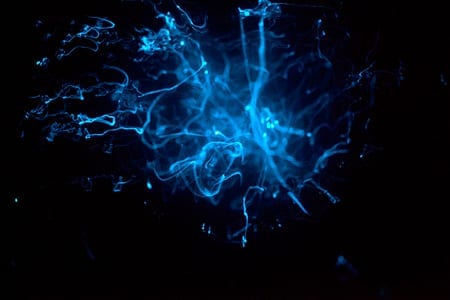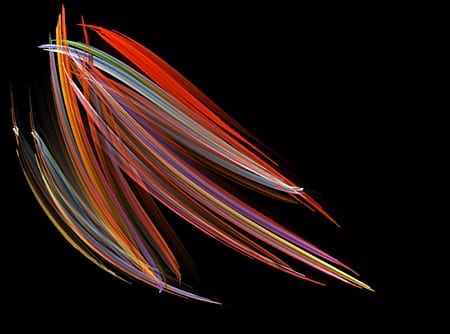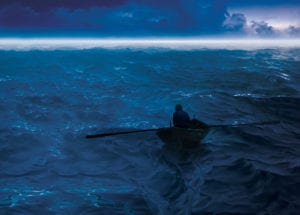By Daniel de la Calle
From Maya Lin’s interview in our film to the recent NYC Pteropod exhibit by Cornelia Kavanagh that we wrote about in April, we have always enjoyed looking at nature, science or Ocean Acidification through an artistic filter. With that in mind we bring you now a sample plate made of beautiful films, sculptures created with plastic debris, photo exhibits, art contests and visually captivating scientific research that might inspire you, deepen your understanding of things or spark a revolution:
≈≈≈≈≈≈≈≈≈≈≈
The current “Washed Ashore: Plastics, Sea Life and Art” project at the Chula Vista Nature Center features enormous fish, coral reefs, turtles and jellyfish created from plastic bottles, flip-flops, ropes, trash cans and much more. Angela Haseltine Pozzi is the artist behind it, a native of Oregon that found inspiration and motivation after seeing the pristine beaches of her childhood “become cluttered with plastic pollution.” And she adds:”I now see the essential purpose of my work is not only to create strong aesthetically sound sculptures, but also to bring awareness and dialogue about the oceans’ environmental issues. I believe the power of the arts can carry urgent messages forward into the public eye.”
SOURCE
≈≈≈≈≈≈≈≈≈≈
It was June 5th, 1761, when close to two hundred scientists spread around the world to observe the transit of Venus, hoping that by watching from different stations they would be able to measure the distance from Earth to the Sun. That event probably marked the first attempt at global scientific cooperation. Fast forwarding now to the present times, artist Lynette Wallworth saw a connection between this historic collaborative effort at observing celestial objects and the state of our colorful coral reefs of today, in desperate need of a multinational campaign. That is how she began two years ago working with a microscope instead of a telescope on the film “Coral: Rekindling Venus” around
reefs in Indonesia, Papua New Guinea, Florida and Australian laboratories, in the hope of being finished for this year’s transit of Venus. I bet you just saw tv coverage of that planet of love and feminine beauty crawling in front of the sun; now you also stand the chance (if you are in New York at least) of seeing the mesmerizing images of “Coral: Rekindling Venus” at the planetarium of the American Museum of Natural History.
The film has no narration because Ms Wallworth believed it is all about the emotional experience. “I know the information is out there — I think our connection to this community is not,” she says. So what the film does instead is reveal in extreme close up a vibrant miniature universe of creatures caught up in the struggle for life and reproduction, lushly eating and moving in a display that proves how the small can explain the big, that proportions and detail are bewitching and that sometimes just one word can be one too many.
Do press “Play” to watch the official trailer and/or the interesting TEDxSydney talk by Lynette Wallworth below. You shall not be disappointed:
≈≈≈≈≈≈≈≈≈≈
Since early May and until mid September you can visit a unique art display involving five teams of scientists and artists at the EDF Foundation in Paris. 
Under the title Carbon 12 this eclectic group exhibit “aims to build a bridge between contemporary art and climatology around the central role carbon plays in current ecological evolutions.” The themes, artists and scientists are:
Ocean Acidification
A large work by David Buckland representing a chalk cliff, illustrates his response to the research led by Debora Iglesias-Rodriguez (National Oceanography Centre, UK) on the Arctic coccolithophores’ role in the absorption of carbon and the acidification of the oceans.
Technologies of maritime energy
With the help of drawings, installations and sculptures, the British artist Annie Cattrell reformulates research on the ocean’s role in energy production, the use of the swell and operation of submarine turbines led by Mark C. Bell (ICIT/Herriot-Watt University, UK) and Simon Boxall (National Oceanography Centre, UK).
Atmospheric Volatility
With “Domestic Disaster 3: Planet Earth”, HeHe (a duo formed by Helen Evens and Heiko Hansen) recreates a miniaturized polluted atmosphere placed on a world map. Colourful and artificial, animated by a slow and steady movement, accompanied by a sound choreography, this atmosphere echoes the research on fluid dynamics led by Jean-Marc Chomaz (CNRS, Laboratoire LadHyX, France).
The damage to the biodiversity of forests
Lucy + Jorge Orta, in resonance with findings made by Professor Yadvinder Malhi (Environmental Change Institute Oxford, UK), will show a wall of photographs of flowers, digitally reworked, taken during their expedition to the Peruvian Amazon in 2009. Three showcases containing moulded sculptures recall the primary role – as carbon trap – of the Amazonian biodiversity for the ecological balance of the planet.
Maritime pollution
A series of photographs and a video created by the American artist Erika Blumenfeld, who worked with Michael Latz (researcher in maritime bioluminescence, Scripps Institution of Oceanography, USA) underline the fundamental role of phytoplankton in the cycle of oxygen’s renewal (up to 50%).
An accessible and educational scenography, videos conceived in close collaboration with scientists, as well as documentaries on Cape Farewell’s work, will allow all members of the public to learn more about the scientific elements involved in the completion of the different works of art.
SOURCE
SOURCE 2
≈≈≈≈≈≈≈≈≈≈
We want to mention again the Ocean Ark Alliance art challenge for Year 9-12 to be showed at the Melbourne Aquarium on October 22nd, 2012. This fantastic project is currently Victoria (Australia) based, but organizers hope it to eventually become a national and international initiative.
for the $50,000 prize moneys.
To REGISTER
your school’s interest
To become a SPONSOR
SOURCE
≈≈≈≈≈≈≈≈≈≈
Under the continuing and growing effects of acidification our oceans will kill an unknown number of phytoplankton. We have previously written about it, I know, about how phytoplankton might be the planet’s most important organism, both basic to the marine food chain and provider of half of the oxygen in the atmosphere. HERE is a very valid article by Stephen Leahy about the latest research by Chinese and German scientists on diatoms, but the simple reason to be mentioned here is that they represent the symbolic contribution by nature to this post about art, beauty and creation. Just look at the photograph of these diatoms.

Credit: Michael Stringer
SOURCE


